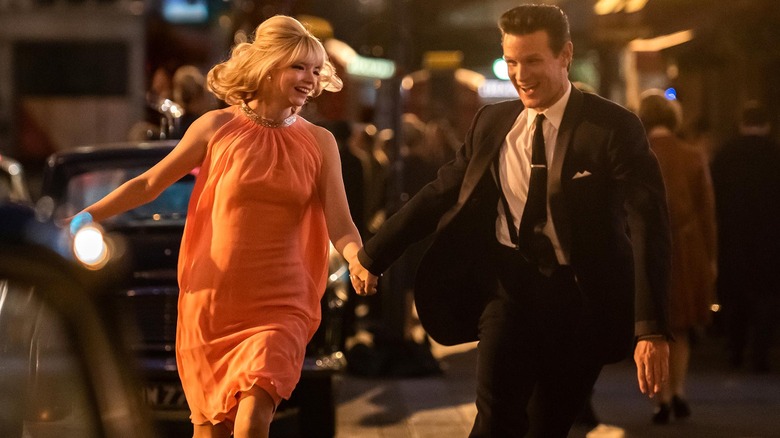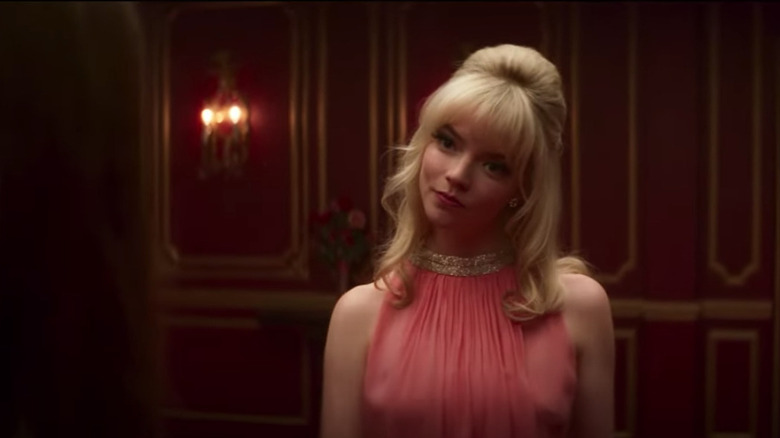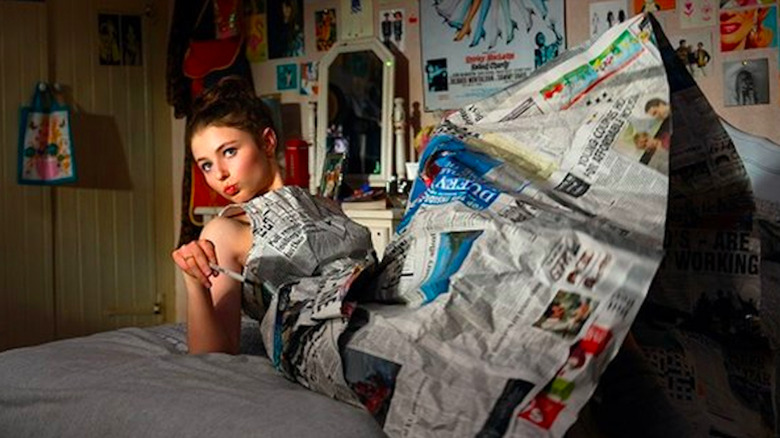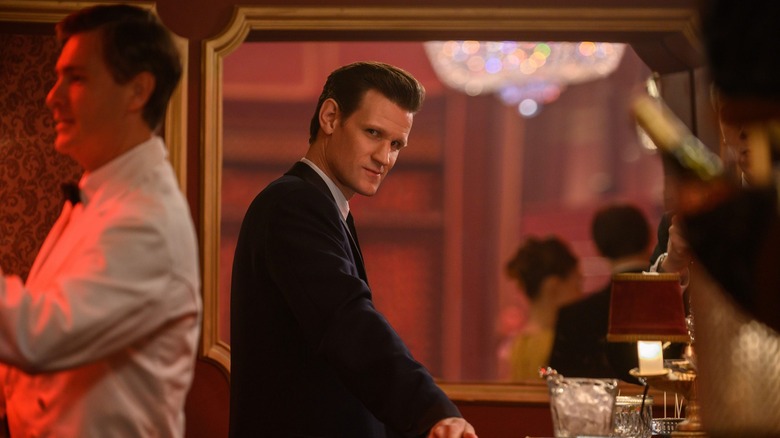Last Night In Soho Costume Designer Odile Dicks-Mireaux Brings '60s London Back To Life [Interview]
Odile Dicks-Mireaux's work in "Last Night in Soho" is an undeniable treat for the eyes. Set in the world of high fashion and swinging '60s London, the costume designer behind "An Education" and "Brooklyn" got to bring, as she put it, "razzmatazz" to Edgar Wright's horror film. The dresses and suits are a dream, especially during the nostalgic Eloise's (Thomasin McKenzie) first few nights in the past.
Unlike Eloise, the costume designer isn't nostalgic at all for fashion from the past. She does, however, appreciate the damn fine pinstripe suits and other items from the era. During a recent interview, Odile Dicks-Mireaux told us about her work on bringing those costumes to life and more about her time on "Last Night in Soho."
I had to design a dress that would inspire a whole fashion show.
You just worked on a film set in '50s London. What are the main differences between costume designing for '50s London and '60s London?
Close but completely different, and different period. I mean, early '50s you're coming out of that whole, much more structured, couture kind of shape where everyone's much more cosseted. The suits are very different, bigger shoulders, I think. I can't remember, but now I just did '53 and then I've done '50 and I've done '61 in "An Education," which is slightly different. In the later '50s you get the slightly slimmer silhouette, the longer line down to the knee, which carries through into the '60s. So you get a bit of a crossover, but the early '50s is very different to the mid '60s. And also, what's nice is then because we did '65 to '68. That's a big change as well. So for instance, I think if you were a woman trying to make your own clothes in the early '50s, that would've been much harder to do the really kind of classy look.
Whereas I think in the mid '60s, the looks are very much simpler and really it was all about the quality of the fabric that you could buy, but you could get a cutter, simpler look, I think much easier. Which is kind of the thinking behind Sandy is that she would not have bought a Dior dress. She would've had it made because there would've been a lot of makers. My mother made clothes, but she would go and buy a nice piece of fabric from say, Liberty's, which was an expensive fabric shop. And so, that was my thinking about Sandy, for her to be able to get into the Café de Paris, now, here's a girl with, I don't know what income she's got. I like to have a little bit of a backstory when I'm developing a character. She would have to have a dress that you'd believe that she could own.
On top of that, obviously I had to design a dress that would inspire a whole fashion show [Laughs]. There had a couple of color elements in there that I was trying to match. I quite like thinking through those things, because I think that's a good ground basis to start your design on and then go instinctively start looking at reference and then something often jumps out when you, and then you present that to your director. And then you've got a chance of kind of convincing him. That's a really good idea.
You mentioned designing for a whole fashion show, but I also imagine the Halloween party was a tall order.
Oh yeah. Well actually I have to be honest. I have to put my hands up there. I didn't do the Halloween party. My team considered me too old and they said you've never been to a Halloween party and they'd all been to Halloween parties. And that is true. We didn't do Halloween parties in my 20s and 30s. So they said, go away, we'll do it for you. And they had such fun and they did try to do some iconic Halloween costumes and try and get them the copyrights for them, which became quite complicated. Then they very cleverly contacted all the people through the crowd casting and said there was going to be a competition that Edgar would judge at the end. So that was an incentive.
I can't remember who won, who it was. I think it was the guy with all the bones. He got all these bones and cleaned them and put them all over his costume. But they were really lovely. What's so nice when you get a crowd who join in with the fun of making the film, they looked great. Didn't it? I was so proud of them. I mean, if there was something there I hated, I would've said no.
How about making audiences believe the outfits, such as the pink dress, fashion students are making today in school?
I sort of hit it from three sides. Edgar liked the dress. That was the prototype for Sandy's dress. It was came from a color that Twiggy wore in the period that I really liked. We went for the peach, which I think was a good choice. I chose a really expensive silk chiffon, which drove my maker mad. I kept saying, "Can we take a little bit more out? I'm just really worried that it doesn't look as stretching as I'd like." And [Anya Taylor-Joy] used the dress in that wonderful way on the dance floor. Nobody knew she was going to do that, which was lovely. And then, we went on and I said to my maker, "We've now got to design a fashion show."
I showed it to a young fashion student and asked her to come up with something. Then we also had a fashion consultant who was helping recreate the classroom. They were accurate about how they would be taught, because Edgar, like me, loves details. I was thrilled when the art department suggested a fashion consultant who is a fashion designer herself. My maker and I worked together on it. I said what I wanted. My maker then said, "Look, I'd love to do the drawings for you. Let me do the drawings for you." We then showed them to the fashion consult as if she was a student. So, we played a strange path to get there to the point we then presented it to Edgar.
Edgar came up with the idea of the three colors, which was nice, that were, the red to turquoise and the peach. And so, we tried to do it like we were students ourselves, because I was worried we would over-design it. At the end, we managed to contact the crowd supervisor, who's doing the crowd. We got some names of real fashion students and asked them if they would donate their fashion collections, which were quite extra, all very different. We picked very different ones. So I couldn't say to you there was a trend we thought, but in that last, you've got real clothes that belong to actual young fashion designers, just hoping to make their way into the world.
Newspapers are good fabric.
Like you said, you and Edgar love the details, so what were some specific, little details meant a lot to you?
Well, [a] little detail, for instance, the newspaper dress we chose, we couldn't use real newspaper because of the copyright, which was unfortunate, because newspapers are good fabric. We had to print something, so we then said, "Why don't we approach a Cornish newspaper? Because she comes from Cornwell." That's where a little detail comes in. Nobody might see it, but we all knew that everything printed on that dress was from a Cornish, local newspaper who was very happy to sign away their copyright. Then in the journey of the costumes, there's a combination of collaboration between the team. I'm presenting stuff to the team and working with the makeup and hair designer and working with the production designer. It was a journey. We decided to establish Sandy's costumes first.
And then, I used some of those elements to reflect back into Eloise's wardrobe and her journey. So when we chose the peach dress, we then found a pink vintage, '90 shirt and I thought, oh, that'd be great. Let's try that on Thomasin. She could wear it the day after she's seen that dress as if it was in her wardrobe, little details like that. Originally, she was going to buy a black lace dress in the shop, so I felt, let's have a black lace dress on Sandy, so there's a reason why she'd be attracted to the idea. In fact she didn't, she then bought the Mac 'cause then we found another Mac and then everybody said, "Oh, why don't we make a Mac? We'd have two girls in white Mac." So, that came out of a collaboration and a discussion.
The white Mac came out of the image of Julie Christie from "Darling." One of the films that Edgar gave us. He gave us 15 films to watch and loads of reference. I like that idea, so she had to wear a Mac. We went through black, red, yellow, and then we all kind said, "Why not white?" It was quite funny because when we tested it, the cameraman was a bit worried, but everyone said, "Let's go for it. You know, it'll be fine. It might glow a bit, but maybe that'll add something to the film." And then I thought, well I'll put the black lace later back in once she transforms into the blonde, I felt all her clothes were less of a fashion student nature.
They were more of a girl kind of obviously descending into the level of horror, but also wanting to have an element of '60s in it. I used Brigitte Bardot there with the baggy beatnik jumper, then the black lace, because everybody seemed to have black in '60s and the black lace then reflected back on Sandy. There are all those sort of little nuances, so somehow her clothes sit well in the film. You feel the journeys are smooth. I hope so, anyway.
Why does newspaper make for good fabric?
It's very good fabric. It moved better than the printed fabric. We made a prototype, right? For Edgar to see Thomasin move it. And then, when we came to shoot it, Edgar shouted up to me and said, "It doesn't move well. What's wrong?" I just got to crumple it a bit more and I think it'll be okay. [Laughs] So I went in there tried to destroy this dress ... kind of softened. And then for that, we used the late '50s imagery, more early '60s for the newspaper dress because we felt that's what Thomasin, not only if she's interested in Twiggy, but she was interested in a whole range of from the late '50s, '60s. I think was reflected a bit in her bedroom, Audrey Hepburn from "Breakfast at Tiffany's."
The newspaper dress is a good character detail.
Yeah, it was in the script, obviously Edgar and [co-writer] Krysty [Wilson-Cairns] came up with that idea. In fact, my maker always likes to do a bit of research herself and said he can go on YouTube and there are quite a lot of examples of people making things out of newspaper. So it kind of seemed logical then that somebody stuck in cold water to make something out of newspaper and also had to be a great silhouette and a potentially possible that she could make it. It wasn't overly complicated.
I don't feel a nostalgia for it.
Obviously this film is so much about the dangers of nostalgia. Do you have much nostalgia for fashion of the past?
No, I don't, actually. I lived through the '60s and I made all my clothes and watched my mother make her clothes. I made my clothes quite bonkers things when I look back on it in the late '60s and early '60s, because it was much more colorful, more hippie, and long skirts. I don't feel a nostalgia for it. I think I just find it fascinating clothes reflects the politics and society of that time and what's available there.
You're always fascinated as a designer thinking, what is everybody wearing now? I think fashion always takes things from the past, as well, and recreates it. It's pleasurable when we went looking for the stock, led to Paris and around the costume houses, first of all, and learning the period, that's a great way of learning about it. You're feeling the real clothes, real things, but there are some things about it. You think, glad I don't have to wear that anymore. I can wear something way more comfortable in terms of being respected.
Those suits from that time depicted in the film are great, though.
Nice suits. They're nice. Sometimes when you're researching your character, you ask, "How would they be inspired? What would they be looking at?" And obviously in that time in the '60s, men would've had bespoke suits. That was very common at the time, getting your first suit. I looked at Albert Finney and Lawrence Harvey for him. I found some great fabrics. We chose the pinstripe suit. We went for a very midnight, slightly off black for the dinner suit and just did it for the period of the time, '65. And then, we changed it a little bit further down, but I don't think he ever saw that the turquoise-y mohair suit, which was slightly bit more '68. We brought a little bit more razzmatazz in it. So, he start straight off as a businessman. And then you realize later on that, he's not quite so [Laughs].
They're nice suits. It's a nice line. They're quite long and Matt's quite tall. So, they're very flattering. He was quite chafed, I think, but he was good. Sometimes what you find now is actors will take them in too much and you keep telling it's coming off the shoulders. There're more shoulders it in that period. When you go into the late '60s and into '70s, a lot more shoulder coming back again. When you go into the '80s, I've done the whole of '80s suits, that's very different as well.
What's different about the '80s suits?
Well, the '80s are interesting. You look at Johnny Depp, early '80s. He looks like he's wearing a 1950s suit. And then when you go right through the '80s, you get to '87, it's gone slim again. Back to the '60s a little bit. Helmut Lang came in and made these very slim suits again. It is fascinating just to see the changes. Now, we're going to go we've had the shorter suit and then we'll go longer again, I think.
"Last Night in Soho" is now playing in theaters.



